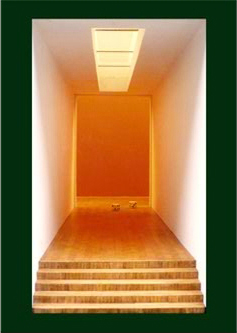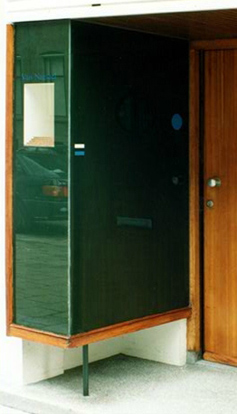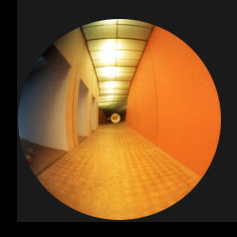Jacqueline Pennell at Museum van Nagsael (2002)
artdesigncafé - art | 4 October 2011
This interview was previously published in World Sculpture News, 8(3), 37-9 in 2002 with the title "Luck of the dice".
Jacqueline Pennell at Museum van Nagsael
|
Double sixes will do it. With the (un)lucky roll of the dice triggering an endless hall of mirrors with multiplying entrances and exits, Jacqueline Pennell’s Aleatoric (2002) responds to Hieronymus Bosch’s 16th-century depiction of "Hell". [1] Conceived specifically for the three-part intervention, A Triptych across Time: Artists Respond to Bosch’s “Garden of Delights” [* Eden * Hell * Garden of Delights] at Rotterdam’s Museum van Nagsael (MvN), a miniature replica of a museum built to scale (1:15), Pennell’s installation "suggests the uncertainty that endless chance events can induce, and the certainty that the future will be no different." Jacqueline Pennell’s contribution, the second installation of the three, contained within a two-sided, glass-covered display window. [2] The site and project were chosen in response to Museum van Nagsael’s miniature size as "the world’s smallest museum" in relation to Bosch’s work— his usage of scale, distortion, and depiction of world order. At MvN, two viewpoints are offered: facing the street at eye level, and also through a fish-eye peephole fitted into the side of the cabinet offering a closer and distorted view of the artwork. With this installation, Pennell addressed the site and the project, resulting in an interplay among the miniature, infinity, and chance events— with a minimal manipulation of reflective material. Based in London, Jacqueline Pennell has created several mirrored interventions placed in unusual areas— underneath sofas, in fireplace hearths, discreet garden locations, and underground passageways. Her works playfully distort and expose these previously "hidden areas". Pennell has exhibited work in Amsterdam, Brussels, London, and in other parts of the United Kingdom. In addition to her practice, she is a lecturer in fine art at Goldsmiths College, University of London. R.J. Preece, who organized the project, interviewed Pennell to discuss the connections, abstractions, and contexts. R.J. Preece: When the project was formed, you seemed pleased to be offered "Hell". Why is that? Jacqueline Pennell: I find Hell more intriguing since it represents our fears, and I feel these are directly related to constructing our desires. I also thought that there would be a broader scope for exploring and interpreting psycho-dynamics. As I have a musical background, the musicians in Bosch’s panel appealed to me— the unpredictable improvisation— as well as other elements: the gamblers, the addictions, and the darkness of the hell fire. R.J. Preece: Could you explain the conceptual and visual development you undertook when designing the Museum van Nagsael intervention? |
Jacqueline Pennell: I wanted to expand this miniature space beyond its physical boundaries, and to create an installation which you can’t actually enter but draws you into a spatial and conceptual experience. To enable Aleatoric to provide a means for the viewer to explore their idea of Hell, through their own experiences, thereby bringing the installation into the real world again. This begins to merge with the territory of illusion and thereby back to the Garden of Delights and Bosch.
R.J. Preece: You divided the experience into two distinct parts— via the Museum’s front view and side view with fish-eye lens. Could you explain your reasons for this and your intention?
Jacqueline Pennell: As the two different viewpoints are physically divided, the viewer needs to pull the two visualizations together— not only what I’ve installed, but also what they bring to Aleatoric. It’s like piecing together a puzzle, putting together the multiviews seen in the mirrors via the fish-eye. Including the dice suggests game playing, gambling, and chance events. By including the dice in the front space, this implies that the viewer has thrown them, has taken that step, that risk. What results are multiple possible outcomes of such action, and this can induce uncertainties and insecurities about unknown future events.
R.J. Preece: When you were installing, you opted for an orange background instead of a black one. Why?
Jacqueline Pennell: Orange is so seductive, but implies “caution”. I wanted the viewer to be drawn into the space from the street and also into the fires of Hell.
R.J. Preece: In what other ways do you see your intervention as responding to Bosch’s painting?
Jacqueline Pennell: The dice refer to those depicted in the painting. I am asking the viewer to “throw” them and see their future unfold in the multitude of possibilities seen in the mirrors. Bosch intended his painting to be didactic, a warning of what we could become. The viewer may fall into the route that Bosch’s characters follow. But unlike Bosch, I am not telling a cautionary tale. Instead I’m suggesting an unstable situation and how life is fragile, unpredictable and often is directed by chance events.
R.J. Preece: After the project was formed, I learned that Bosch’s painting was listed in an art magazine as one of the top ten favorites in a survey of contemporary artists. Why do you think this might be the case? Is it one of your favorites?
Jacqueline Pennell: I first saw it in the Prado in Madrid in 1988 and was instantly mesmerized. It is a microcosm that draws you into its visceral world where anything goes: pleasure, torture, fucking, shitting, dying, and giving birth. It is raw and explicit. It is everybody’s life in some form or another. We perhaps revel in the details, the multitude of stories and we want to go there.
R.J. Preece: As you know, the project was formed in December 2001, shortly after the terrorist attacks on New York’s World Trade Center and the invasion of Afghanistan. When I was thinking of "Hell", the burning towers and their collapse was the image at the forefront, repeated as it was when flipping TV channels. The repetition of the planes crashing into the skyscrapers. The disbelief. The movie-like fiction turned into fact, all part of our global psyche. And the uncertainty of our world’s future. However, you chose a very different approach to thinking about "Hell."
Jacqueline Pennell: I don’t think I could possibly make a piece of work that could take on board such a horrific experience and the enormity of the global political situation. However, I do want to be able to emphasize the importance and value of every person’s life by having a conversation with some of them. By interacting with them— touching people via the medium of art.
I’m not interested in giving an opinion. I am interested in exploring questions which may not and often don’t have an answer. Uncertainty is definitely an approach that I take in making any piece of work, and throwing the die is about fate. At the same time, it’s about learning from our experiences and attempting to take control of our future.
R.J. Preece: When you were finalizing the piece, it struck me how it tied into the body of your work so tightly. Here I’m thinking visually about your installation at the Bank Tube Station (2000) in particular, and the reflective experiences of Slippage (1999) and Mirror Mirror (1996).
Jacqueline Pennell: What I try to explore in my work is tightly bound up with questions I ask myself— about facing oneself, understanding where you are, what you have achieved and where you want to go. I deliberately put the viewer into a position of facing themselves— and facing their lives. They have had choices and they will have them again. They have made wrong decisions and right ones, and the future is unknown.
R.J. Preece: Which artists and/or artworks do you see as important reference points to your practice? How do you see this as relating to the art historical contextualization of your art?
Jacqueline Pennell: Michelangelo Pistoletto is fundamental to my development, as well as Joseph Beuys, Richard Wilson, Robert Smithson, Louise Bourgeois, and Christian Boltanski. I was really excited to see recently, in the Museum of Modern Art in Brussels, Pistoletto’s Green Curtain and Nam June Paik’s I Ching 36. My work relates to site, architecture, and space, to raw matter, emotional responses, the earth we stand on, and personal experience, in that the viewer is an important participant in the work.
R.J. Preece: What drives you to work with reflective material? Your works may be a professional result of a process, but is there anything that is a personal reference point?
Jacqueline Pennell: I’m a bit of a dreamer. I always think spaces and our lives are multi-faceted in their construction. That there is another view which is unavailable to you. That you cannot see it, but it is always there. I use the mirror as a tool to explore this “other area”.
Notes:
[1] Hieronymus Bosch, The Garden of Delights, c. 1510-15, oil on panel. Museo del Prado, Madrid. See standard art history survey books for illustrations.
[2] The third part of the intervention continues in August 2002 with London-based artist Jeremy Wood addressing Bosch’s central panel, ["Paradise"]. In April 2002, Susan Morris addressed the first part of the triptych "Eden" with her video installation Between Two Deaths (1998-2001), a bleached-out, black-and-white line drawing moving up and down across the screen, which reveals itself as a cropped detail of two bodies in the act of making love. (Click to read more about the project).


